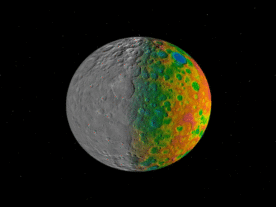
This NASA/ESA Hubble Space Telescope image, released 7/25/16, reveals the vibrant core of the galaxy NGC 3125. The galaxy is located about 50 million light-years away in the constellation of Antlia. (ESA/Hubble & NASA, Judy Schmidt)

The Solar Impulse 2 plane comes in for a landing in an airport in Abu Dhabi, United Arab Emirates, early 7/26/16 and completes its circumnavigation of Earth. The Solar Impulse 2 was able to make it’s a complete trip around the world without a drop of fuel, powered solely by the sun’s energy. (AP)

The Soyuz MS-01 spacecraft is seen two hours before it launches from the Baikonur Cosmodrome in Kazakhstan on 7/7/16. The rocket sent expedition 48-49 crewmembers Kate Rubins of NASA, Anatoly Ivanishin of Roscosmos and Takuya Onishi of the Japan Aerospace Exploration Agency (JAXA) to the International Space Station. (NASA)

Pokemon Go the smartphone game application released on 7/6/16 has already become a worldwide phenomenon. Here a Pokemon Go player finds Exeggcute, a Pokemon, at Bayfront Park in Miami, FL on 7/12/16. (AP)

A successful developmental test of RS-25 rocket engine No. 0528 was conducted on 7/29/16 at NASA’s Stennis Space Center, near Bay St. Louis, Mississippi. The RS-25 engine will be used for the most powerful rocket in the world – the Space Launch System (SLS), which will launch humans deeper into space than ever before, including on the journey to Mars. (NASA)

A robot that will be used to produce lithium-ion batteries at the new Tesla Motors Inc., Gigafactory is displayed on 7/26/16, in Sparks, Nev. (AP)

This is an artist impression of the triple star system HD 131399, which is a mere 320 light years away. Astronomers who used a telescope at the European Southern Observatory in Chile announced their discovery on 7/7/16. (L. Calçada/ESO)

An Amorphophallus titanium, known commonly as the corpse flower begins to bloom on 7/28/16 at the New York Botanical Garden in New York. This rare plant’s scent, released during a 24–36-hour peak, is said to smell like rotting flesh. It is the first time since 1939 that the New York Botanical Garden displayed the stinky plant as it bloomed. (AP)

This is the heart of the Crab Nebula as captured by the NASA/ESA Hubble Space Telescope. This stunning image was released to the public on 7/8/16 features the nebula’s central neutron star. Scientists say it spins at a rate of 30 times per second which produces a visible pulsating appearance, much like a beating heart. (NASA/ESA)

SpaceX’s Dragon cargo spacecraft, sitting atop a Falcon 9 rocket, was launched from Cape Canaveral Air Force Station in Florida on 7/18/16. Among the 2,268 kilograms of cargo it carried were instruments to perform the first-ever DNA sequencing in space. (NASA/Tony Gray)

The humanoid robot, “Alter,” is displayed at the National Museum of Emerging Science and Innovation in Tokyo. The robot features human-like movements of arms, fingers, the upper torso, its head as well as facial expressions. The exhibition runs until 8/6/16 in Tokyo. (AP Photo/Koji Sasahara)

Here are the aquanauts of NASA’s Extreme Environment Mission Operations (NEEMO) 21 mission, which began on 7/21/16. The 16 day simulated space mission is being held at the Aquarius Reef Base, located nearly 19 meters below the surface of the Atlantic Ocean in the Florida Keys National Marine Sanctuary. The purpose of the mission is to evaluate tools and mission operation techniques that could be used in future space missions. (NASA/Karl Shreeves)

Scientists with NASA’s Dawn mission were surprised to find that Ceres has no clear signs of truly giant impact basins. This image shows both visible (left) and topographic (right) mapping data from Dawn. (NASA/JPL-Caltech/SwRI)

NOn 7/19/16 Astronomers using data from NASA’s Wide-field Infrared Survey Explorer (WISE) mission announced that they have discovered an X-shaped structure in the bulge of the Milky Way, which is located in the center of our galaxy. (NASA/JPL-Caltech/D.Lang)
























It´s so wonderful images and only possibly in science.